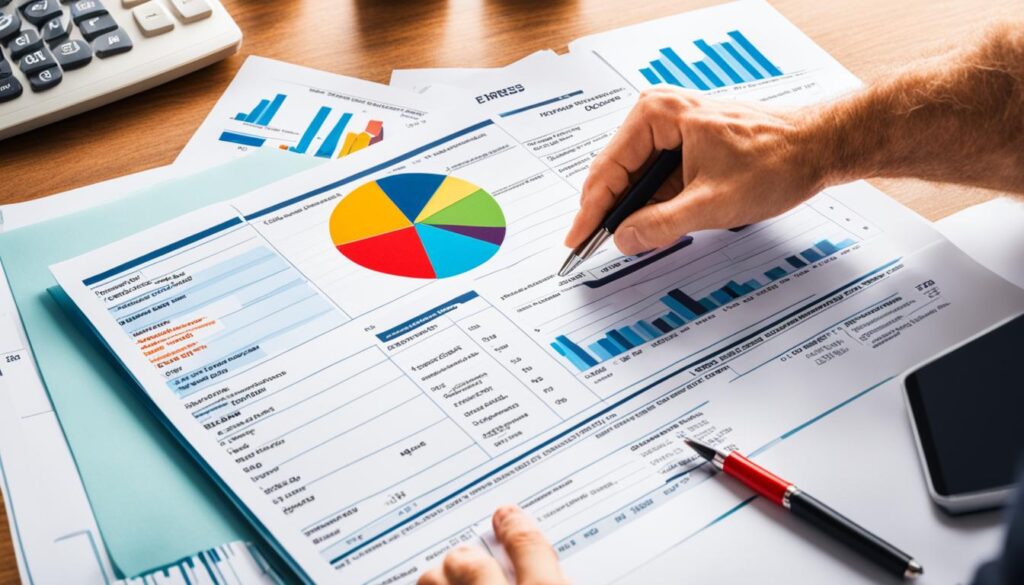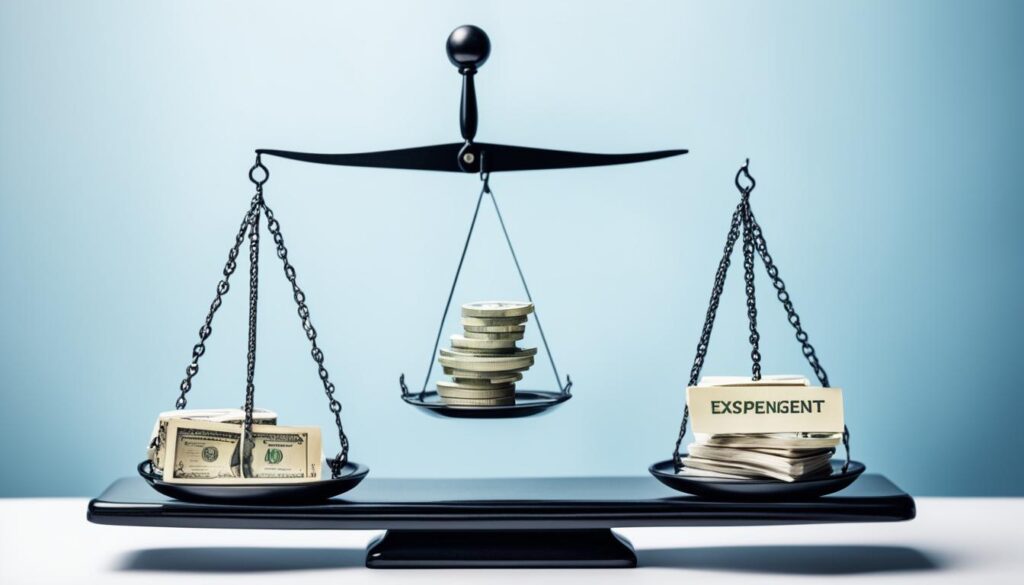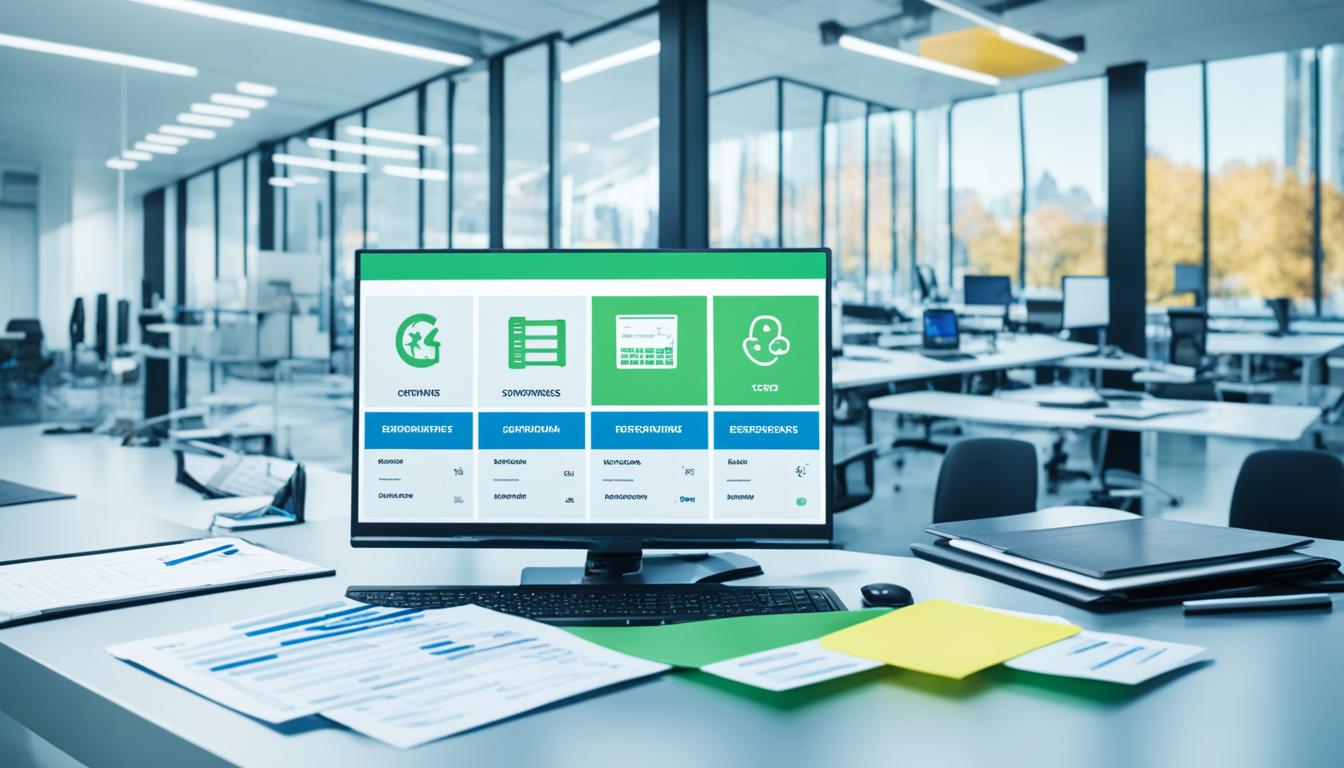Did you know that the ongoing costs of running a business can be similar to your personal living expenses? When comparing the expenses of operating a business to your personal financial obligations, you might be surprised by the similarities.
Key Takeaways:
- Operating expenses are incurred through a business’s normal operations and are essential for its continuity.
- Overhead expenses are not directly related to labor or production but are necessary for running the business.
- Managing ongoing costs is crucial for the financial health and success of the business.
- Regularly reviewing and adjusting expenses can help optimize ongoing costs and financial performance.
- Proper management of ongoing costs is an ongoing process that requires careful planning and decision-making.
Understanding Operating Expenses
Operating expenses are an integral part of running a business and are essential for its continued operation. They consist of various costs incurred in the day-to-day activities of a company, including the materials, labor, and machinery required to manufacture products or provide services. Managing these expenses effectively is crucial for business financial management and small business cost management.
Reducing operating expenses can significantly impact a business’s profitability, but it’s important to carefully consider the potential implications on productivity and overall profitability. Balancing cost reduction with maintaining quality and efficiency is key. To help track and manage operating expenses, businesses can utilize innovative business expense tracking tools.
Optimizing Operating Costs with Expense Tracking Tools
Expense tracking tools are powerful aids for businesses to monitor and manage their operating expenses. These tools provide real-time insights into spending patterns, allowing businesses to identify areas for cost reduction and optimize their financial performance. By systematically tracking and categorizing expenses, businesses can gain a comprehensive understanding of where their money is being allocated.
“Expense tracking tools enable businesses to uncover areas where operational costs can be minimized, leading to improved profitability and financial stability.”
With the ability to generate reports and analyze data, such tools enable businesses to make informed decisions and implement strategies to reduce expenses strategically. By identifying trends and patterns, businesses can pinpoint opportunities for efficiency improvement and cost reduction, ultimately enhancing business financial management.
Expense tracking tools not only provide a comprehensive overview of operating expenses but also enable businesses to set budgets and track expenditures against those budgets. This allows for better control over expenses, ensuring businesses stay on track and avoid overspending.
| Benefits of Expense Tracking Tools |
|---|
| 1. Enhanced visibility and transparency into operating expenses |
| 2. Identification of cost-saving opportunities |
| 3. Improved budgeting and expense control |
| 4. Streamlined reimbursement process for employees |
| 5. Simplified auditing and compliance with financial regulations |
Final Thoughts
Understanding and effectively managing operating expenses is a fundamental aspect of business financial management. By leveraging business expense tracking tools and analyzing spending patterns, businesses can optimize their operating costs, increase profitability, and ensure long-term financial stability.
Understanding Overhead Expenses
When it comes to managing the financial health of your business, understanding and optimizing overhead expenses is key. Unlike operating expenses that are directly tied to production or labor, overhead expenses encompass the general functions required to run your business smoothly and efficiently.
These expenses include accounting services, facility costs, marketing expenses, and other administrative functions essential to day-to-day operations. It’s important to note that overhead expenses are typically fixed costs, meaning they remain constant regardless of your business’s level of production or output.
Proper budgeting and monitoring of overhead expenses are crucial for optimizing your business’s operational costs and maximizing profitability. Regularly reviewing and assessing your overhead expenses allows you to identify areas where cost reduction and optimization are possible.
To help you better understand the various categories of overhead expenses, here is a breakdown of the functions they serve within your business:
| Overhead Expense Category | Function |
|---|---|
| Accounting | Financial record-keeping, tax preparation, auditing |
| Facility Costs | Rent, utilities, property maintenance |
| Marketing | Advertising, promotions, market research |
| Administrative | Office supplies, software subscriptions, professional services |
By analyzing each category of overhead expenses, you can identify areas where cost reduction or optimization may be possible. For example, exploring more cost-effective software solutions or renegotiating lease agreements for your business premises.
Optimizing your overhead expenses not only helps manage your business’s financial resources effectively but also contributes to long-term sustainability and growth. Remember that these expenses should be regularly reviewed and adjusted to align with your business’s goals and objectives.
Proper management of overhead expenses is an essential part of sound financial management for any business.
To gain even greater control and visibility over your overhead expenses, consider utilizing business expense tracking tools. These tools provide valuable insights into your ongoing expenses, allowing you to make data-driven decisions and allocate resources more efficiently.

How Ongoing Costs Impact Your Business
When it comes to the financial management of your business, ongoing costs play a crucial role. Understanding how these costs impact your business is essential for making informed decisions that can increase profitability and ensure long-term sustainability.
By tracking and analyzing your ongoing costs, you can identify which expenses are contributing to your business’s success and where it’s possible to cut back. This analysis allows you to make strategic adjustments, optimizing your expenses for maximum efficiency.
One key aspect of managing ongoing costs is the comparison of expenses over multiple reporting periods. This approach helps you understand trends and potential concerns, allowing you to take proactive measures to address any potential issues. Comparing your business’s ongoing costs can provide valuable insights into your financial health and help guide your decision-making process.
Take, for example, a comparison of your business’s operational costs versus your personal expenses. Understanding how these two categories differ can shed light on areas that may require attention or adjustment. Let’s look at a hypothetical scenario:
“John is a small business owner who meticulously tracks his business expenses and also maintains a budget for his personal finances. Upon comparing his business’s operational costs to his personal expenses, he realizes that his personal expenses are significantly lower. This prompts him to reevaluate his business’s overhead expenses, such as rent, utilities, and insurance. John discovers that he can potentially renegotiate his business lease, switch to a more cost-effective insurance plan, and implement energy-saving measures to reduce his utility costs. By taking these actions, he can align his business’s operational costs more closely with his personal expenses, leading to increased profitability.”
As demonstrated in the example, examining the comparison between business operational costs and personal expenses can highlight areas where cost reductions or optimizations may be possible. This evaluation allows business owners to align their ongoing costs with their personal financial goals, ultimately improving the overall financial health of their business.
Note: The image above depicts a visual representation of a business expenses comparison. It reinforces the importance of analyzing ongoing costs and making informed financial decisions for your business’s success.
Strategies for Managing Ongoing Costs
Managing ongoing costs is a critical aspect of small business cost management and effective business expense budgeting. By implementing strategic cost-saving measures, businesses can optimize their financial performance and ensure long-term sustainability. Here are some strategies to consider:
1. Collaborate with your finance department
Working closely with your finance team is essential for identifying areas of cost reduction without compromising productivity and profitability. They can provide valuable insights into your business operating costs versus personal expenses and help you make informed decisions.
2. Explore cost-saving opportunities
Consider exploring various cost-saving opportunities to cut down on ongoing expenses. For example:
- Downsizing office space or renegotiating lease terms
- Reducing marketing expenditures by focusing on targeted campaigns
- Optimizing energy consumption to lower utility bills
- Considering alternative staffing options, such as freelancers or part-time employees, to reduce labor costs
By carefully evaluating each expense category, you can identify areas where cost-saving measures can be implemented while still maintaining the quality and efficiency of your operations.
3. Regularly review and adjust expenses
An effective business expense budgeting strategy involves regular review and adjustment of expenses. Monitor your ongoing costs closely and identify any areas where expenditure may be excessive or unnecessary. Continuously analyze the data to look for trends and deviations from your financial goals.
“Regularly reviewing and adjusting expenses can help businesses optimize their ongoing costs and financial performance.” – John Smith, CFO at ABC Company
By staying proactive and making necessary adjustments, you can ensure that your ongoing costs align with your business objectives and contribute to your overall financial success.

Note: Image illustrates the importance of small business cost management.
Implementing these strategies for managing ongoing costs will promote efficient financial management, maximize profitability, and foster the long-term growth of your business.
Conclusion
Understanding and effectively managing ongoing costs is crucial for the financial health and success of your business. By categorizing expenses into operating and overhead costs, you can gain valuable insights into your financial operations and make informed decisions. Carefully monitoring and analyzing your ongoing costs allows you to identify areas where you can reduce expenses, increase profitability, and plan for future growth and investments.
Proper management of ongoing costs should be a top priority for businesses of all sizes. By consistently tracking and evaluating your expenses, you can identify opportunities for cost reduction without compromising productivity and profitability. This ongoing process ensures that you stay proactive in managing your business’s financial resources and optimizing your performance.
Ultimately, by effectively managing your ongoing costs, you can align your business’s expenses with your personal living expenses. This contributes to better business financial management, making your venture more sustainable and profitable in the long run. Whether it’s through smart budgeting, identifying cost-saving strategies, or regularly reviewing your expenses, taking control of your ongoing costs is the key to achieving financial success for your business.
FAQ
What are operating expenses?
Operating expenses are the costs incurred by a business through its normal operations, such as materials, labor, and machinery used in production.
What are overhead expenses?
Overhead expenses are costs not directly related to labor, production, or materials, including accounting, facility costs, and marketing expenses.
Why is it important to manage ongoing costs?
Managing ongoing costs is crucial for the financial health and success of a business as it helps increase profitability, sustainability, and identifies areas for cost reduction.
How can businesses manage ongoing costs effectively?
Businesses can manage ongoing costs effectively by tracking and analyzing expenses, regularly reviewing overhead expenses, exploring cost-saving strategies, and making informed decisions.
How do ongoing costs impact a business?
Ongoing costs impact a business by influencing profitability, financial performance, and planning for future growth and investments.


